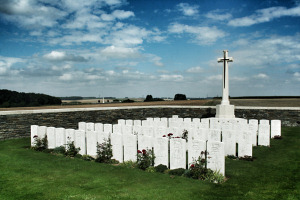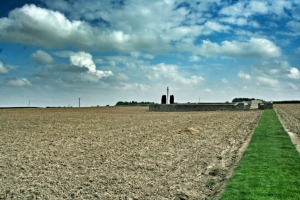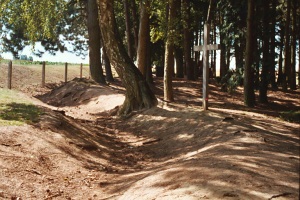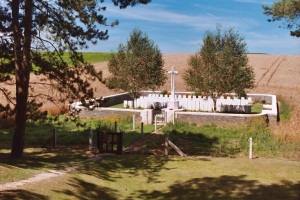
Although the town of Albert has the advantage of proximity to the Somme battlefields, I have preferred recently to use Arras as a base: there are more options for accommodation and eating, and the city is conveniently located to visit other sites closely associated with the Accrington Pals, notably Oppy-Gavrelle and Ayette.
Wherever you choose to stay, an interesting and less-frequently used route to Serre is to drive first to the village of Couin and then to follow the roads that wind eastwards through the villages of Bertrancourt, Courcelles-au-Bois and Colincamps in which the Accrington Pals were billeted in the weeks preceding the Battle of the Somme.
| Click here for a map of the route from Couin to Serre |
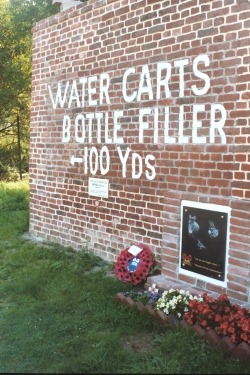 |
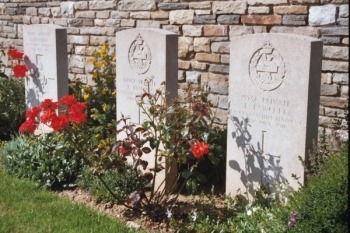 Left: The brick wall at Couin.
Above: The graves of 15807 John Hoyle and 15932 Frank Fawcett, Bertrancourt Military Cemetery. |
Couin, a 25 mile (40km) drive south-west from Arras, merits a visit to see the directions to a water-point in the village, originally painted on the brick wall of a barn in 1916. The wall - to be found at the lower end of the village - has recently been restored; the result isn't to everyone's taste, but at least this piece of history has been preserved.
Return to the centre of the village, and turn left towards Authie following the D2 and D152. After 1¼ miles (2km), turn left onto the D176 to Bus-lès-Artois and Betrancourt. The road soon passes Warnimont Wood, from where the Accrington Pals left for the trenches in the early evening of 30th June 1916. In Betrancourt, turn right onto the D114 towards Acheux-en-Amiénois; after 330 yards (300m) turn right again onto a narrow lane to reach Bertrancourt Military Cemetery. Of the 13 Accrington Pals buried in this cemetery - used by a Field Ambulance in 1916 - 12 were casualties from the battalion's tour of the front line of 19th-24th June 1916.

Above: Bertrancourt Military Cemetery.
Return to Bertrancourt, and follow the D114 to Courcelles-au-Bois. In the centre of Courcelles, turn right to Colincamps. After ¾ mile (1.1km) turn right onto the D129 then, 140 yards (130m) later, turn left to pass through Colincamps. After passing the village church, continue along the D4129 for 1 mile (1.5km) to reach Euston Road Cemetery; there are 24 identified graves here to Accrington Pals who lost their lives on 1st and 2nd July 1916. Continue on the D4129 for 550 yards (500m) to its junction with the D174, then turn right to reach the Mailly-Maillet to Serre road after a further 550 yards (500m). Turn right, and in 175 yards (160m) park the car off the road on the track leading to Sucrerie Military Cemetery. It is a walk of ¾ mile (1km) to the cemetery which stands alongside the tree-lined track from Colincamps down which battalions marched to the trenches.1 Of the four Pals buried here, Jack Clark - killed by shellfire on the night of 29th/30th April 1916 - was the battalion's first fatality in action.
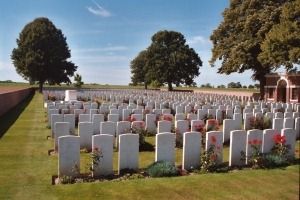 |
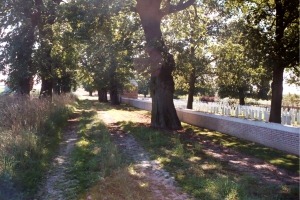 |
Above: Euston Road Cemetery, Colincamps.
Click to enlarge |
Above: Alongside Sucrerie Military Cemetery, the lane leading from Colincamps to the trenches.
Click to enlarge |
The road to Serre passes Serre Road Cemetery No.2 and the French Serre Hébuterne National Cemetery before reaching Serre Road Cemetery No.1 after 3 miles (5km). Park here to visit the Serre battlefield. The cemetery reaches across the former No Man's Land, the entrance being close to the site of the German front line of 1916. Cross the road and walk a few yards up the lane that leads on to Redan Ridge. A few steps to the east of the lane is a likely location of the machine gun manned by Otto Lais on the morning of 1st July 1916.
Above: Serre Road Cemetery No.3, looking north-east across No Man's Land with the copses and Queens Cemetery visible on the left. Six Accrington Pals have named graves in this cemetery, sited close to the 1916 British front line.
Click to enlarge |
Above: Queens Cemetery; looking east over No Man's Land from the site of the 1916 British front line.
Click to enlarge |
100 yards (90m) from Serre Road Cemetery No.1 towards Serre village, a well-signposted track leads to Sheffield Memorial Park. Of the four cemeteries that can be reached on the track, all but the most distant, Luke Copse British Cemetery, contain graves belonging to Accrington Pals. The track crosses the former No Man's Land to reach the site of the 1916 British front line just ahead of Serre Road No.3 Cemetery. From here the track runs gently downhill, parallel and 20 yards (18m) west of the front line. On reaching the woods, a swing gate leads into Sheffield Memorial Park where a memorial to the Accrington Pals, made out of Accrington brick and dedicated in 1991, stands adjacent to the remains of a trench.2 The Accrington Pals advanced up the slope from here towards the German lines some 220 yards (200m) away. Half-way across the former No Man's Land is Queens Cemetery where 50 Accrington Pals lie in named graves.
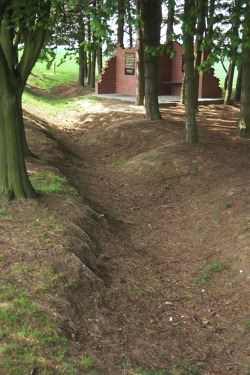 |
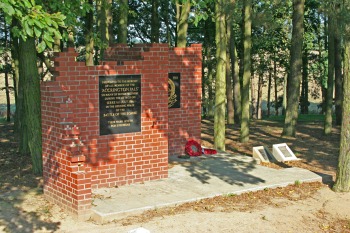 Left: Sheffield Memorial Park.
Above: The memorial to the Accrington Pals in Sheffield Memorial Park. Click to enlarge |
A path leads downhill through the remnants of trenches and shell holes in the park to reach Railway Hollow Cemetery, where there are 15 identified graves of Accrington Pals. It is also worth following the line of the trench north from the swing gate to see the concrete cross erected to the memory of Albert Bull who was killed with the Sheffield City Battalion on 1st July 1916 and whose body was found close to this spot only in 1928.
Outside the park, the track goes on to Luke Copse British Cemetery, crossing the ground over which the Sheffield City Battalion attacked, before meeting the Serre-Hébuterne road at Pierrard Farm.
Returning to Serre Road Cemetery No.3, a track to the right leads onto the exposed slopes behind Railway Hollow Cemetery down which the third and fourth waves of the Accrington Pals had to advance before even reaching the British front line.
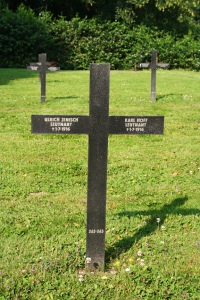 |
Leaving Serre Road Cemetery No.1 by car, follow the D919 through Serre to Puisieux. A short detour eastwards from Puisieux along the D27 allows a visit to the German cemetery at Achiet-le-Petit; buried here are four officers from I.R.169 who lost their lives in the defence of Serre on 1st July 1916: Lt. Heinrich Beck, Lt. Karl Hoff, Lt. Otto Imle and Lt. Ulrich Jenisch. Rejoin the D919 at Bucquoy and take the opportunity to visit the Ayette battlefield before continuing along the D919 to return to Arras.
Left: Graves of Lts. Ulrich Jenisch and Karl Hoff, Achiet-le-Petit German Cemetery. |
Notes
- See page 93 of "The Somme Battlefields" by Martin and Mary Middlebrook (Viking, 1991). The Accrington Pals were amongst those to use this track, though they did not do so on the evening of 30th June 1916. [back]
- The trench at the eastern edge of Sheffield Memorial Park is often mistakenly said to be the remains of the British front line. The error can be traced back to 1928 when the remains of a trench were uncovered and dug out while the ground was being cleared (Sheffield Daily Telegraph, 22nd March and 20th June 1928). In reality, the front line lay up to 50 yards (45m) to the east of where the memorial to the Accrington Pals stands today, and on a different alignment. [back]
© Andrew C Jackson 2005-2018
Email:
|






